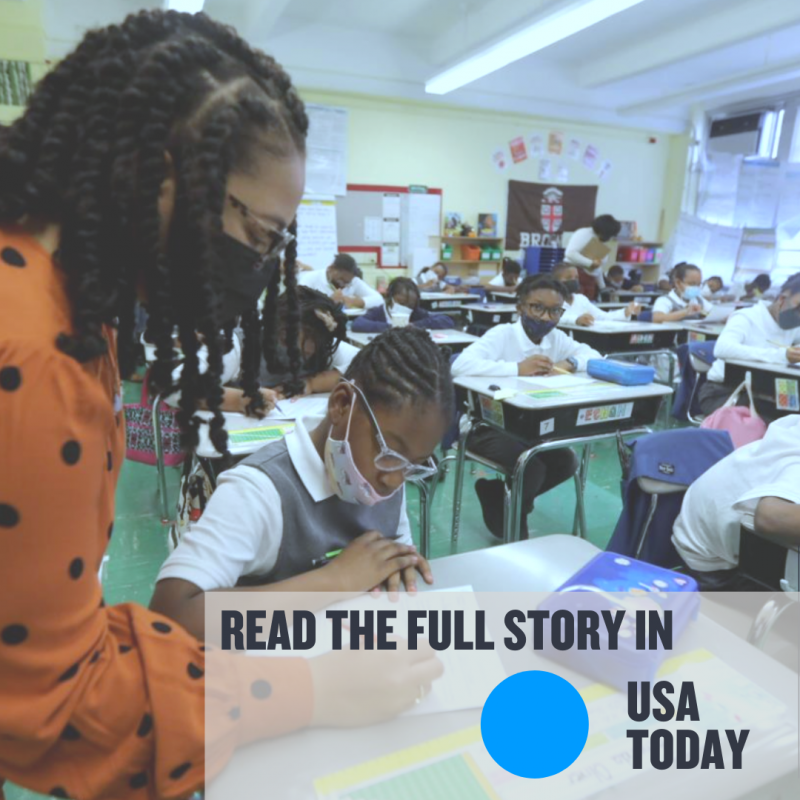By Erin Richards, Emily Bloch, Gary Stern, and Christine Fernando
Algebra classes taught by Nadine Ebri look different than the ones you probably took in school.
Students practice equations through singing, dancing and drawing.
Activities are sculpted around their hobbies and interests: anime, gaming, Minecraft. Problem- solving is a team sport, rather than an individual sprint to the right answer.
Ebri, a math teacher and tech specialist for Duval County Schools in Florida, is using new techniques designed to promote equity. If kids of color, girls and low-income students engage, they’ll be more likely to pursue high-level math classes, the argument goes. That can open doors to competitive colleges and lucrative careers.
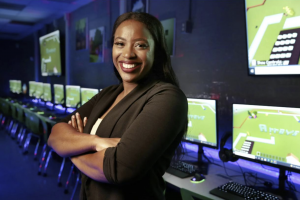
After Ebri switched to emphasizing real-world problems and collaboration, her students, most of whom are Black, improved their scores on Florida’s math exam in 2020-21 – even with 1 in 3 learning from home.
But other, bolder recommendations to make math more inclusive are blowing up the world of mathematics education. Schools are collapsing math “tracks” to put kids of all abilities in the same classes and adding data science courses that carry the same prestige as calculus, long seen as a gateway to a career in STEM fields – and elite colleges.
Another heated issue: the extent to which math education should include real-world problems involving racial and social inequities. Fairly or not, that debate has landed in the murky soup of “critical race theory” digressions.
The changes have pitted mathematicians and math educators against each other and sparked criticism from affluent parents upset by the elimination of gifted tracks. They’ve caused upheaval in one state, California, as professors, parents and teachers spar over proposed changes to the state’s K-12 math framework.
“We’re not changing or lowering the standards. We’re outlining how inequitable the teaching of math is right now,” said Jo Boaler, a Stanford University math education professor at the forefront of the changes.
Opponents say the new movement effectively dumbs down math education.
Lower-achieving students often have deficits that begin in the early grades, and that’s where the focus and energy should go, says Wayne Bishop, a mathematics professor at California State University, Los Angeles.
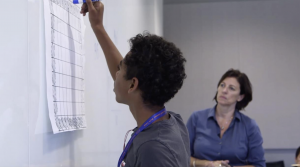 Increasing hands-on projects can move more children up the pipeline, he says. But that doesn’t mean students are well-prepared.
Increasing hands-on projects can move more children up the pipeline, he says. But that doesn’t mean students are well-prepared.
The result is that more people are admitted to college but fewer are prepared for a hard science or engineering college regimen,” Bishop said.
Math wars in California
Many low-income students and kids of color aren’t doing well in math and haven’t for a long time, national test scores show. That translates to big divides later in lucrative STEM fields – science, technology, engineering and math – where 70% of workers are white and 65% are male, according to a survey by the American Enterprise Institute.
The pandemic has only made things worse. A new national report shows third-grade students’ math scores dropped significantly during the pandemic. Only 17% of third- graders at majority white schools performed on grade level in math this fall; just 4% of students attending majority Black schools did the same, according to the report by Curriculum Associates.
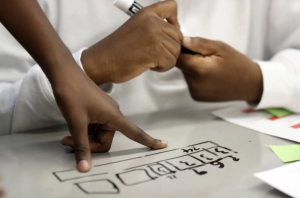 But scholars and parents are debating how to improve instruction to boost historically lower-achieving students without slowing down high-flyers – especially when many advanced students come from affluent families resistant to change.
But scholars and parents are debating how to improve instruction to boost historically lower-achieving students without slowing down high-flyers – especially when many advanced students come from affluent families resistant to change.
Making math more relevant by using real-life problems around social inequities has struck a nerve, as Republicans accuse teachers of overemphasizing race and racism in subjects such as American history. Many GOP-led states have passed laws aimed at curtailing such discussions.
Proponents of the framework changes in California, on the other hand, have encouraged working equity discussions into math class.
This program is quite a comedown for math, from an objective academic discipline to a tool for political activism,” said Williamson M. Evers, a former Republican Department of Education official, in a Wall Street Journal opinion piece. He suggested California’s proposals mean 2 + 2 no longer equals 4.
Critics of the new approaches say teachers need to double down on teaching routine math basics to help low-performing students improve.
“A real champion of equity and justice would want all California’s children to learn actual math – as in arithmetic, algebra, geometry, trigonometry and calculus – not an endless river of new pedagogical fads,” says a letter to the state signed by 1,163 math and science professors.
Many math educators disagree. They want all that same math to be taught, they say, with a stronger focus on access and equity.
“We value the role that mathematics can play in highlighting and ultimately addressing social injustice,” says a letter headed by the California Mathematics Council and signed by more than 1,500 math and science educators and parents.
From kicked out of class to dropping a math beat
Ebri, the math teacher in Jacksonville, started to change her teaching habits in the throes of the pandemic. She spent less time testing students’ understanding and more time connecting their personal interests to math activities, which helped build their confidence.
“Kids should never have to change who they are to assimilate into classroom culture,” Ebri said. “I should change my instruction to fit their needs.”
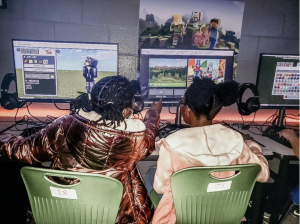
Ebri had already achieved a small amount of math teacher fame. In 2016, a video of one of her lessons went viral online, garnering tens of millions of views. It was a middle school algebra class, predominantly filled with Black students, working on long-division prompts scrawled on a whiteboard.
“I was just teaching my lesson, describing the process in the style of a rap: ‘You’re gonna divide, multiply and subtract, bring it on down and bring it on back,'” she recalled.
One of the students dropped a beat on a desk, thumping with his hands. Other students started chanting the long-division process – “Divide!” “Multiply!” “Subtract!” – interjecting with “ayes” and cheers in between. Students took turns at the board, dancing while solving the problems.
The student who started beating actually got kicked out of class a few years earlier,” she said. “Everything that defined his behavior, I instead integrated into my class.”
Ebri’s teaching style earned her a Teacher of the Year finalist nomination and a promotion: She now oversees technology innovation with Duval Schools’ lab programs.
Still, as a Black woman teaching STEM in the South, Ebri says her techniques aren’t always taken seriously.
“It’s one of those things where I just have to show it works with my beta. My kids continue to score in the top percentile,” she said.
Axing gifted tracks works, districts say
Leaders in districts ushering more underrepresented kids into harder math classes say it hasn’t diminished opportunities for advanced students.
Six years ago in Hartford Public Schools in Connecticut, leaders noticed significant racial disparities between students in advanced and regular classes. Latino and Black students make up more than 80% of the district, but advanced math classes mostly enrolled white and Asian kids.
Hartford eliminated Honors Algebra I and enrolled all students in Algebra I instead, effectively eliminating ability tracking in ninth-grade math. It also encouraged teachers to recommend students for advanced high school classes even if they lacked attention or focus, which could have kept a kid out of such classes in the past.
The results have been encouraging. Between 2014 and 2019, Hartford’s elementary and middle school students made steady gains on the state math exam, according to Mario Carullo, Hartford’s director of mathematics. Math scores on the SAT steadily ticked up for high school students.
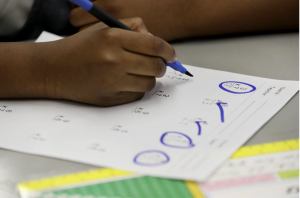 In suburban Chicago, Evanston Township High School has started detracking math classes after doing the same in subjects such as English and science. Many offer a pathway to honors credit: If students take and pass the honors assessments, they receive a half-point boost in their grade point. Giving more students a chance to succeed has boosted enrollment in advanced classes.
In suburban Chicago, Evanston Township High School has started detracking math classes after doing the same in subjects such as English and science. Many offer a pathway to honors credit: If students take and pass the honors assessments, they receive a half-point boost in their grade point. Giving more students a chance to succeed has boosted enrollment in advanced classes.
“Since we implemented ‘pathways to honors’ geometry classes, my AP enrollment has gone up,” said Jake Mills, who teaches geometry and AP statistics. He now works data science problems into his stats classes, such as by having students analyze racial disparities in traffic stops by the Evanston police.
“We’ve got more students excited about math and about doing difficult math,” he said.
Before the change, students tested into one of four levels in each subject, based on eighth-grade scores and other criteria. Once tracked, moving into advanced classes later was nearly impossible, administrators say.
Evanston Township also started offering a precalculus and AP calculus class exclusively for students who identify as Black. It follows the regular curriculum, but students of color feel better supported, said teacher Jamilah Dorsey. The high school also offers an Algebra II class exclusively for students who identify as Latinx.
When the calculus course started, students often stopped by to see it for themselves. In the past, Dorsey says, a class with all Black students was almost always lower level.
It’s not critical race theory, teachers say
Across the country in Oklahoma City, math teacher Telannia Norfar once passed out graphs showing racial demographics of prison populations and asked students what they noticed. Many were shocked by the disproportionate incarceration of Black people.
That was almost a decade ago.
“Now I have to be careful,” said Norfar, who teaches upper-level math courses at Northwest Classen High School.
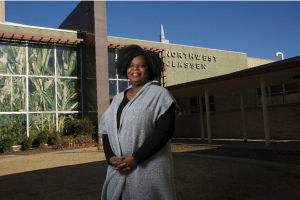
The reason behind her caution: a nationwide deluge of so-called critical race theory bans aimed at limiting the way classrooms teach about racial equity. While critical race theory, a decades-old legal framework for examining systemic racism, is not taught in most schools across the country, teachers say the term has become a catchall for any discussion of racism, equity and slavery.
Discussion of the bans has centered around social studies classrooms, but Norfar says the debate is also chilling vital discussions in math and threatening progress to make curricula more applicable to students’ diverse experiences.
“If you are a math teacher and not having your students use the math skills they’re learning to make sense of the world, they’re missing out,” Norfar said. “That world we want them to learn about has complex, dynamic issues. Sometimes it’s ugly and painful. But if you have a tool set that includes math and science to help you make sense of that world, you’re better off.”
Drilling basics, explaining answers – fast
In Brooklyn, New York, math instruction at Leadership Prep Canarsie, an elementary charter school, is fast-paced, collaborative and loud. The style of teaching is designed to keep everyone engaged.
Most students here are Black and low-income – and they’re outpacing their peers statewide in math. About 69% of Leadership Prep Canarsie students and a partner middle school scored proficient on the state math exam in 2019, compared with 47% of students statewide.
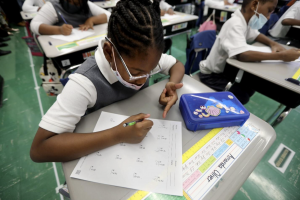 Math classes begin with skip-counting – students calling out number patterns, like times tables, in cheerleading style to build fluency. Then there are one-minute quizzes on recent lessons, with students reviewing each other while teachers listen. Students explain their answers to the class; those off track are quickly queried about their reasoning.
Math classes begin with skip-counting – students calling out number patterns, like times tables, in cheerleading style to build fluency. Then there are one-minute quizzes on recent lessons, with students reviewing each other while teachers listen. Students explain their answers to the class; those off track are quickly queried about their reasoning.
Activities and discussion happen in three minutes or less. Students respond to verbal prompts in rhythm.
“Now I have a challenge,” fourth-grade teacher Kaitlyn Chin said.
“Bring! It! On!” the class shouted.
“The idea that math is only for people who are good at math doesn’t apply here,” said Alexandria Timoll, dean of curriculum and instruction.
Leadership Prep Canarsie is part of Uncommon Schools, a network of 57 charter schools in New York, New Jersey and Massachusetts. The organization emphasizes math understanding by having students explain and model their thinking.

“The idea is not to pursue the right answer at all costs,” said Paul Powell, assistant superintendent of Uncommon Schools. “We want students to develop fluency with numbers, a conceptual understanding – each time we move a decimal place, what does that mean? – and to be able to apply what they’ve learned.”
Recently, fourth-grade students were paired up for a multiplication word problem. Serenity Griffith, a student, modeled her work on a screen.
“I put the lesser amount here and the greater amount here,” she said. “I realized I didn’t know where to put my difference. Then I figured it out.”
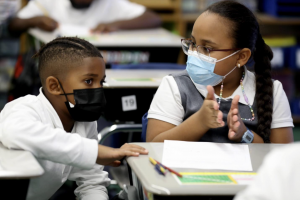
“Nice job, girlfriend!” shouted her classmates.
Who will win the debate?
Advocates for emphasizing math facts and those pushing for problem-based exercises both have a point, says Robert Floden, a professor at Michigan State University who studies mathematics teacher education.
But detracking classes doesn’t work well if teachers have to meet the needs of students of varying abilities without any additional support, he says.
Joya Pramanik, a parent of a high school junior, says that’s what happened when San Francisco Unified started eliminating math tracks. Pramanik’s daughter, who likes math, grew bored in middle school when the district eliminated accelerated math pathways.
Pramanik paid for private, online math classes so her daughter could accelerate outside of school through pre-algebra and then Algebra I. She figured out where to schedule an algebra placement exam that would let her daughter accelerate faster once she got to high school. Now her daughter is in honors precalculus, Pramanik says.
“I know they’re doing this work for equity reasons, but I think they’re negatively affecting the community,” Pramanik said.
In Yonkers, New York, parent Cheryl Brannan didn’t think her daughter was getting enough support in math and science class, either. That was 10 years ago, but it prompted Brannan to launch an outside tutoring program for Black girls.
Brannan’s daughter, Sayidana Brannan-Douglas, now 24, remembers being tracked in high school. She was placed in advanced algebra in ninth grade, but not advanced earth science, based on her middle-school scores.
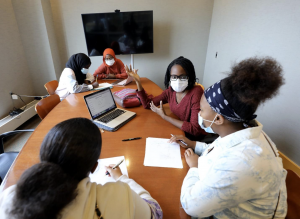
Since then, Brannan-Douglas and more than 1,000 middle and high school students in Westchester County have participated in her mom’s summer camps or year-round programs to practice math and science skills and to learn about careers in STEM fields.
Brannan incorporates culturally relevant math and science learning into Sister to Sister International, a nonprofit she runs that promotes African culture among Black girls. Every year, graduates who studied math and science in college return to tutor and mentor younger girls.
Brannan-Douglas now knows she would have been fine in advanced science with additional resources, akin to those found in the camps and workshops her mom started.
She went on to attend SUNY’s Stony Brook University, majoring in technological systems management.
“In middle school, I wasn’t underqualified,” she said. “I was underresourced.”
Photo Credits:
Bob Self, Florida Times-Union
斯坦福大学
Seth Harrison, The Journal News
Sonya Duke-Bolden, Duval County Public Schools
Doug Hoke, The Oklahoman
Mark Vergari, The Journal News

